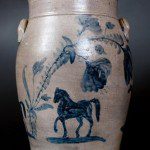Governor Gooch had a secret.
Virginia Governor William Gooch had good reason to hide the truth in his 1732 annual report to the British Board of Trade. The colonies were forbidden to engage in manufacturing any products in direct competition with those imported from England, except for those that would benefit the mother country.
Yet, he and his government had long encouraged local entrepreneurs, including a Yorktown merchant known as William Rogers.
An enterprising brewer and businessman, Rogers’s pottery was one of Virginia’s most prosperous businesses, producing 23 types of redware and stoneware, which were shipped up and down the East Coast. Since the quality of Rogers’s vessels was comparable to anything imported from England, and clearly posed a conflict, Gooch maintained his deception until the end of the decade.
The most utilitarian pottery available, redware was one of the first necessities that the colonists made themselves. It’s no wonder Governor Gooch was covert about this flourishing industry. Redware pots were used like plastic is used today. They were comparably cheap, plentiful and locally crafted, using clay with high iron content (this is what gives redware its characteristic red or orange hue).
Redware jugs, jars, plates, bowls and tavern ware of various kinds were used throughout 17th- and 18th-century America. If the housewife needed it, the potter made it. Unfortunately, the potter, or anyone who regularly used redware vessels, commonly developed nervous disorders, like palsy and tremors, associated with lead poisoning.
There are multitudes of contemporary pieces on the market that are being advertised as antiques. Hence, collectors should educate themselves to be able to discern fakes.
Examine the back of the piece to see if it is blackened, which would indicate that it was used on the hearth and is likely an old piece. Since tallow or fat leaches into clay, smelling the piece for faint remnant odors of either can help determine whether it’s an older item. A glaze with a glassy quality is a sign of a modern piece.
Stoneware was developed due to the fear of poisoning from lead-glazed earthenware. Made of dense, blended clays, salt-glazed and then fired to vitrification, stoneware was imported to the colonies from England and Germany.
Early American redware potters rarely inscribed their names in the soft clay, but stoneware quite often bears the maker’s mark. Crocks, jugs, butter churns – chiefly utility items – were typically decorated with freehand cobalt decoration of flora, fauna and, occasionally, military motifs. An urn featuring Civil War soldiers recently sold at auction for $350,000.
The mellow, golden-colored ware is a type of stoneware made of fine yellow clay that was found along riverbanks in New Jersey and other Mid-Atlantic states. Since the yellow clay contains a lower level of iron, causing it to vitrify at higher temperatures than red clay, yellow ware items were much harder and more durable for kitchen use.
The collector can determine whether an older piece is American yellow ware by tapping it: American pieces will thud; English yellow ware will ring. It was a popular choice for kitchen use up until the 1940s, when homemakers began to be seduced by pieces made of modern materials.
The south has a wide and diverse 200-year history of pottery, covering multiple states. Southern redware and stoneware research has made significant strides in the last 25 years. Entire new schools of pottery have been discovered, uncovering new forms and traditions.
The pottery of the “Great Road” represents some newer discoveries of the southern pottery tradition. The Great Road, considered part of the “Great Wagon Road” initiating in Philadelphia, was the primary route from Roanoke, Va., to eastern Tennessee.
A wonderful piece of antique American folk pottery, whether it is redware, stoneware or yellow ware, has its own distinct past. A potter – who probably dug his own clay, mixed his own glaze recipe and fired his pieces in old wood-fired kilns – made each piece, and every piece tells its own unique story.
An antiques dealer for more than 25 years, Michelle Galler owns Antiques, Whimsies & Curiosities, based in Georgetown and in Washington, Va. Contact her at antiques.and.whimsies@gmail.com to suggest a topic for a future column.





